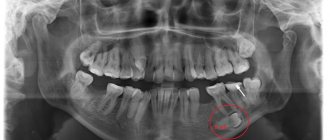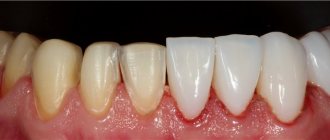Preparing teeth for prosthetics begins with an examination by an orthopedic dentist. It determines the scope and list of measures that will be required to effectively restore the integrity of the dentition.
The basis of preparation is accurate diagnosis. The condition of both jaws can be assessed using a panoramic X-ray - orthopantomogram. It allows:
- see the condition of all teeth;
- assess the condition, volume, structure of the bone tissue of the jaws;
- identify diseases that may interfere with prosthetics (periodontitis, root cysts, etc.);
- determine the condition of soft tissues, the depth of periodontal pockets with periodontal disease, etc.
Based on the diagnostic results, the doctor determines what preparation measures will be required.
Therapeutic preparation
Therapeutic preparation is necessary for the purpose of sanitation of the oral cavity. First of all, professional teeth cleaning is carried out:
- removal of hard dental deposits using ultrasound, less often - mechanical cleaning;
- removing soft plaque using the Air Flow method;
- polishing, fluoridation (remineralizing therapy).
Preparing teeth for prosthetics includes mandatory removal of foci of infection and inflammation. Treatment of caries and complications in the form of pulpitis, periodontitis is carried out, and therapy for inflammatory diseases of the gums and soft tissues of the oral cavity (periodontitis, gingivitis, glossitis, etc.) is prescribed.
Therapeutic preparation also includes removal of the pulp of teeth to be replaced. Afterwards, endodontic treatment is carried out - treatment and filling of the root canals.
Preparation for prosthetics for implantation
If implants are chosen as a support for the crown, the preparation of the oral cavity for prosthetics is the implantation itself and additional surgical operations for its implementation, such as bone grafting, sinus lifting, etc. The entire complex of measures for the implantation of artificial roots is carried out according to a high-precision digital protocol:
- CT and 3 D scanning of the jaws . Using computed tomography and intraoral scanning, a three-dimensional virtual model of the jaws is created, depicting the condition of the oral cavity with high accuracy and detail.
- Modeling of future crowns . The future orthopedic design is modeled digitally and the position and shape of the teeth are selected.
- Virtual placement of implants . The location of the implants is determined according to the virtual model of the jaw, taking into account future crowns, bone volume, localization of the facial nerves and other features.
- Making a surgical template . Based on a digital impression of the patient’s jaw, a real projection is made in the form of a positioning mouthguard, with the help of which it becomes possible to accurately comply with the selected conditions for the placement of the implant at the time of surgery.
- Implantation . Depending on the clinical situation, either classical two-stage implantation or implantation according to a one-stage and/or one-stage protocol is performed. After this, the process of osseointegration—engraftment of the implant into the bone—begins.
The long preparatory stage ends with permanent prosthetics - installation of a crown on an implant, usually screw-fixed. As a result of correctly performed implantation, the patient receives a flawless smile without any risks or complications.
Surgical preparation
Surgical preparation involves the removal of teeth that cannot be treated. For example, highly mobile ones, having a large root cyst, granulating periodontitis, etc.
Osteophytes and exostoses, if present, are also removed. They are outgrowths of bone tissue and can interfere with the installation of a denture.
Surgical preparation of teeth for prosthetics may also include removal of excess soft tissue due to hypertrophy of the mucous membranes and gums.
Implant placement also refers to surgical preparation. Osteoplastic surgery, the implantation of artificial or natural bone tissue to achieve the required volume of bone in the jaw, can also be used as a preliminary stage. One of the types of such an operation is a sinus lift, raising the bottom of the maxillary sinus.
How is prosthetics performed?
Once the oral cavity is prepared, the prosthetic process can begin. It consists of several stages:
- Preparation of teeth that will be involved in prosthetics: depulpation, removal of excess tissue.
- Taking impressions for subsequent production of a jaw model. Also, instead of impressions, intraoral photography can be used, followed by the formation of a three-dimensional digital model of the jaws.
- Design and manufacture of prosthesis.
- Fitting.
- Installation on permanent cement.
Orthopedic training
Orthopedic preparation involves attention to secondary tooth deformations after removal of those located nearby or “antagonist” (located on the opposite jaw) teeth. It involves creating special plates and trays to move protruding teeth to create space for dentures on the opposite jaw. It may also be necessary to make special trays to relieve the masticatory muscles. This is necessary for bruxism and increased muscle tone to prevent damage to structures.
Preparing teeth for prosthetics is a whole range of measures that are designed to prevent the difficulties of wearing artificial structures and are necessary to ensure oral health.
Why is it necessary to depulp teeth under metal-ceramics?
This question is very often asked by patients at the stage of preparation for metal-ceramic prosthetics . The name of this design makes it clear that it is based on metal, on top of which ceramic coating is applied, after which the prosthesis is fired in a special oven - this procedure ensures the strength of the connection between metal and ceramics. In order to ensure that after installation of the prosthesis it does not overestimate the bite and does not cause discomfort, it is necessary to create space; for this purpose, the supports are pre-prepared, removing the required amount of enamel and dentin. Thus, the layer of tissue protecting the pulp becomes much thinner. This often leads to so-called postoperative pain, increased sensitivity and the possible development of traumatic pulpitis, since the nervous tissue is highly sensitive. If, some time after installing the prosthesis, the tooth under the crown suddenly begins to hurt and become inflamed, then the entire structure will have to be removed, the resulting inflammation treated , and starting all over again.
Date of publication: September 20, 2020 Last update: September 22, 2022 © 2020 Professorial Dentistry “22 Century”. All rights reserved.
Installation of prostheses
When the crowns or dental bridges are ready, the final stage of prosthetics will begin. Installation of structures is carried out in accordance with the chosen method. If removable dentures are performed, the doctor shows the patient how to properly put on and remove the structure from the mouth. A specialist fixes permanent crowns and bridges in such a way that they are securely held on the supporting elements. There is no need to remove such dentures yourself; they remain in the oral cavity permanently.
Before installation, fittings are carried out to show whether adjustment (correction) of the structure is required. After the patient approves the prosthesis, the dentist performs its final fixation.
Psychological preparation
Most people are afraid of going to the dentist. A tense patient, shaking with fear, does not speak well and is difficult to interact with. The work of an orthopedist begins long before trying on a prosthesis. The first step is to establish emotional contact. If a doctor is friendly and shows attention, he inspires trust. The patient will be more open to discussing treatment methods, and nervousness will decrease. During the conversation, the dentist collects information about:
- patient complaints;
- past treatment experience and its results;
- the presence of common diseases and allergic reactions.
During the examination, the orthopedist pays attention not only to the condition of the oral cavity, but to the asymmetry of the face, recession of the cheeks and lips.
To assess the condition of the teeth and see hidden defects, an orthopantomogram (panoramic image) or CT scan is usually prescribed. This is not a whim of the doctor, but a desire to create a complete picture, taking into account all the details. In addition, the image can reveal inflammatory processes that are invisible during examination.
Based on the results obtained, different types of preliminary treatment are prescribed.
- Alekperov R.B. Orthopedic dentist
Question:
I don’t want to remove the nerves in the supporting teeth for the bridge. What are the options?
Answer:
A bridge prosthesis based on zirconium dioxide involves the production of thin crowns for supporting teeth, so in some cases it is possible to do without their heavy grinding and depulpation.
- Pak R.V. orthopedic dentist
Question:
When the teeth are ground, will they put something on the stump? Or just walk around with sharp fangs
Answer:
After the teeth have been prepared, protective temporary crowns are placed on them until the permanent prosthesis is installed.
< Previous Next >
Prices for implantation using templates in Moscow
| Consultation with an orthopedist | FOR FREE |
| Installation of 1 implant | 20,000 rub. |
| Implant INNO, South Korea | 10,000 rub. |
| Implant MIS, Israel | 10,000 rub. |
| Implant NOBEL, Sweden | 35,000 rub. |
| Partial removable denture | 15,000 rub. |
| Complete removable denture | 20,500 rub. |
| Clasp prosthesis | RUB 25,500 |
| Ceramic crown | 21,000 rub. |
| Metal-ceramic crown | 5,100 rub. |
Financial issue
With extensive dental prosthetics, when the patient faces a fairly long treatment in several stages, for some people, and especially for pensioners, the issue of the cost of prosthetics arises.
Staged payment without increasing the price
A large amount of work on prosthetics often requires considerable funds; not all people can pay a large bill at a time.
Sometimes it happens that the patient cannot pay the entire bill at once, in one payment.
In such cases, the Lyubertsy Dental Clinic VUGI may offer the patient to split the bill into several payments during the production of the required orthopedic structure (14-30 days);
Orthodontic stage
Treatment is aimed at correcting malocclusion and occlusion (contact between the teeth of the upper and lower jaw). Teeth are moved using braces, aligners and plates. This is done not only to correct the bite, but also to correct the position of the supporting teeth and create a place for attaching dentures.
Where to start treatment
Dental prosthetics for pensioners has a number of features. In old age, this is a complex and delicate procedure. A careful and careful approach to treatment is required.
Start by visiting a dental clinic and get a consultation with a dentist. After the examination, the doctor will tell you whether prosthetics can be done and what preliminary treatment is necessary. Before installing dentures, undergo a medical examination. Older patients, as a rule, have a number of chronic diseases and weak immunity.
Please note the contraindications: allergic reactions to anesthesia and substances used in dental prosthetics. It is not recommended to carry out treatment during an exacerbation of diseases of the cardiovascular system and respiratory organs. It is necessary to eliminate inflammatory processes in the oral cavity (stomatitis, bleeding gums). In state or municipal dentistry you can receive treatment under the compulsory medical insurance policy. After treatment, contact your orthopedic dentist and discuss what type of prosthesis and what material will be suitable for your case.
Dental prosthetics cannot be done under the compulsory medical insurance policy.
.
But for pensioners, Russian citizens, social programs
under which prosthetics can be installed for free.
Basic issues of dental prosthetics
Dear friends, in this article we will try to answer the most asked questions by our patients about prosthetics and preparation for it, about the main stages of dental prosthetics, their order and important key points related to dental prosthetics.
Dental prosthetics is a multi-stage process of replacing lost teeth or damaged tooth tissue with the help of dentures. So, after you have been consulted by a specialist, a diagnosis has been made, a treatment plan has been selected, a treatment agreement has been drawn up, and the treatment stages begin. Any dental prosthetics includes: 1. Preparation for prosthetics, if necessary.
2. Dental prosthetics itself, which includes clinical and laboratory stages.
Preparatory treatment planning
The orthopedic dentist, together with his colleagues, other specialists, therapist and surgeon, plans to conduct the process of preparing the patient for prosthetics with precision down to the day.
After the preparatory and further treatment plan is ready, the patient’s schedule of visits to the clinic is clarified, dates and times are agreed upon, from what time to what time the patient should be in the clinic, based on the planned medical activities and his time capabilities.
When all the details are agreed upon, the full cost of treatment is also discussed in detail.
Features of quota provision
If social security confirms the basis for dental prosthetics on preferential terms, you will be given a coupon for applying to a state or municipal medical institution. The coupon is valid from 2 weeks to six months
. If you do not use the ticket at the appointed time, the queue disappears. The beneficiary is not allowed to choose a clinic. The medical institution is designated according to the place of registration, the name of the clinic and address are noted on the coupon.
Free prosthetics for pensioners are provided in state and municipal dental clinics. According to the quota, they will only make and install dentures for you. Treatment is paid separately. Expensive materials are not used for prosthetics. Such as ceramics, metal ceramics and implant prosthetics. In some cases, for example, with allergies, the doctor may recommend more modern and expensive materials. When making such a decision, the patient will have to pay extra for consumables. Free prosthetics are done only once every 5 years
.
Bridge
The main preparation for bridge prosthetics consists of preparing the supporting teeth. When using metal-ceramic dental prosthetics, the teeth are subjected to significant grinding. Zirconium crowns are much thinner, so not as much hard tissue is ground down.
After this, impressions are made and the frame is modeled based on them. Then the crowns are cast and fired in a kiln. The bridge is tried on, adjusted and placed on temporary cement, giving the patient time to get used to it. After this, the structure is secured with permanent cement.










